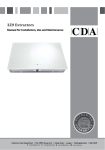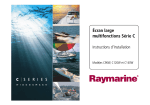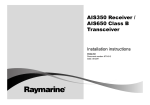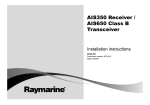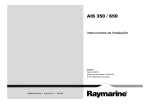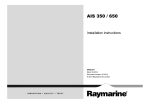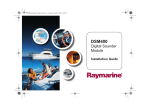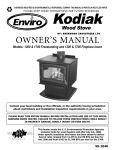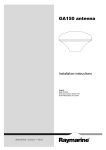Download Raymarine AIS500 System information
Transcript
AUTOMATIC IDENTIFICATION SYSTEM AIS500 Transceiver Installation instructions Trademarks and registered trademarks Autohelm, HSB, RayTech Navigator, Sail Pilot, SeaTalk and Sportpilot are UK registered trademarks of Raymarine UK Limited. Pathfinder and Raymarine are UK registered trademarks of Raymarine Holdings Limited. 45STV, 60STV, AST, Autoadapt, Auto GST, AutoSeastate, AutoTrim, Bidata, G Series, HDFI, LifeTag, Marine Intelligence, Maxiview, On Board, Raychart, Raynav, Raypilot, RayTalk, Raystar, ST40, ST60+, Seaclutter, Smart Route, Tridata, UniControl and Waypoint Navigation are trademarks of Raymarine UK Limited. All other product names are trademarks or registered trademarks of their respective owners. Copyright ©2008 Raymarine UK Ltd. All rights reserved. ENGLISH Document number: 87112-1 Date: November 2008 Contents Chapter 1 Introduction ............................................. 7 Chapter 5 Post installation procedures.................. 35 Applicability .................................................................... 7 Safety information........................................................... 7 General information ........................................................ 8 Requirements for USA & Canada .................................... 9 Requirements for areas outside of USA & Canada............ 11 System information ......................................................... 13 5.1 Switching on ............................................................. 36 5.2 Configuration ............................................................ 36 5.3 Checking for interference........................................... 37 5.4 Using AIS ................................................................. 38 Chapter 2 Planning the installation ........................ 17 2.1 EMC installation guidelines ........................................ 18 2.2 Parts supplied........................................................... 19 2.3 Tools required ........................................................... 19 2.4 Basic system ............................................................ 20 Chapter 6 Diagnostics.............................................. 39 6.1 Status indication ....................................................... 40 6.2 Troubleshooting ........................................................ 41 Chapter 7 Specifications.......................................... 43 7.1 General .................................................................... 44 7.2 Transceiver............................................................... 44 7.3 GPS Receiver........................................................... 45 Chapter 3 Cables & connections ............................ 23 3.1 Cable types and length .............................................. 24 3.2 Routing cables .......................................................... 24 3.3 Transceiver connections ............................................ 25 3.4 Cable shielding ......................................................... 26 Chapter 4 Installation procedures .......................... 27 4.1 Fitting transceiver...................................................... 28 4.2 Fitting GPS antenna .................................................. 29 4.3 Connecting up .......................................................... 31 5 6 Chapter 1: Introduction Applicability The information in this book applies to all geographical areas unless otherwise stated. Safety information Warning: Product installation This equipment must be installed in accordance with the Raymarine instructions provided. Failure to do so could result in poor product performance, personal injury, and/or damage to the vessel. This product is intended only as an aid to navigation and must never be used in preference to sound navigational judgment. Only official government charts and notices to mariners contain all the current information needed for safe navigation, and the captain is responsible for their prudent use. It is the user’s responsibility to use official government charts, notices to mariners, caution and proper navigational skill when operating this or any other Raymarine product. Caution: Power supply protection When installing this product ensure the power source is adequately protected by means of a suitably-rated fuse or automatic circuit breaker. Warning: Switch off power supply Safety Notice Ensure the boat’s power supply is switched OFF before starting to install this product. Do NOT connect or disconnect equipment with the power switched on, unless instructed in this document. RF radiation statement Warning: Potential ignition source This product is NOT approved for use in hazardous/flammable atmospheres. Do NOT install in a hazardous/flammable atmosphere (such as in an engine room or near fuel tanks). Introduction Warning: Ensure safe navigation Your Raymarine AIS500 transceiver generates and radiates radio frequency (RF) electromagnetic energy (EME). Safe Compass Distance Safe Compass Distance is 1 meter minimum for any compass. Some compass types may require greater distances. To be sure, you should locate your transceiver as far as possible from the compass. Test your compass to verify proper operation while the transceiver is also operating. 7 General information Warranty registration Intended Use To register your AIS500 transceiver ownership, please take a few minutes to fill out the warranty registration card found in the box, or visit www.raymarine.com and register on-line. Raymarine AIS500 is an AIS Class B transceiver, and is intended for world wide use aboard leisure marine boats and workboats not covered by International Maritime Organization (IMO) and Safety of Life at Sea (SOLAS) Carriage Regulations. Caution: Cleaning When cleaning this product do NOT use acid, ammonia-based or abrasive products, and do NOT use high pressure washing (jet wash) equipment. Product disposal Dispose of this product in accordance with the WEEE Directive. It is important that you register your product to receive full warranty benefits. Your unit package includes a bar code label indicating the serial number of the unit. You should stick this label to the warranty registration card. Technical accuracy To the best of our knowledge, the information in this document was correct at the time it was produced. However, Raymarine cannot accept liability for any inaccuracies or omissions it may contain. In addition, our policy of continuous product improvement may change specifications without notice. As a result, Raymarine cannot accept liability for any differences between the product and this document. AIS500 installation guide Information scope The Waste Electrical and Electronic Equipment (WEEE) Directive requires the recycling of waste electrical and electronic equipment. Whilst the WEEE Directive does not apply to some Raymarine products, we support its policy and ask you to be aware of how to dispose of this product. AIS disclaimer All information presented by the Raymarine AIS transceiver is advisory only, as there is a risk of incomplete and erroneous information. By placing the AIS500 into service you acknowledge this and assume complete responsibility for any risks associated with this device, and accordingly release Raymarine and SRT Marine Technology Ltd from any and all claims arising from the use of the AIS service. 8 This document gives introductory, installation and troubleshooting information for the Raymarine Automatic Identification System Type 500 Transceiver (AIS500) transceiver. Refer to the ProAIS User Manual and the operating manual for your Raymarine Multi-Function Display, for instructions on how to configure and operate your AIS system. All documents are available to download as PDFs from www.raymarine.com Static data requirement The AIS500 transceiver needs to be correctly programmed with the following vessel data (static data) before use: • Vessel Maritime Mobile Service Identity (MMSI) number • Vessel name • Vessel call sign • Vessel dimensions including AIS GPS antenna location • Vessel type A MMSI number comprises 9 digits, and a full, valid 9 digit value must be entered in order to be accepted during setup. Any number that does not meet these criteria will not be accepted by the system. All other fields (i.e. vessel type, name etc.) are optional. Raymarine AIS transceivers comply with the Federal Communications Commission (FCC) and Industry Canada requirements that regulate marine AIS and VHF radio usage for the US and Canada, respectively. Marine AIS users in the US must comply with all applicable FCC rules and regulations, some of which are described in this handbook. This information was current at the time this handbook was printed. Up-to date information, including licensing requirements, can be obtained on the FCC website at: www.fcc.gov/wtb/marine Official FCC forms can be obtained on the FCC website at: www.fcc.gov/formpage.html If your vessel already has an MMSI number (used for a VHF DSC radio) then the same MMSI number must be used to program the transceiver. FCC Notice If a valid MMSI number is not entered, the AIS500 will enter Silent Mode and will not transmit. However, it will still operate as a receiver. This device complies with part 15 of the FCC Rules. Operation is subject to the following two conditions: Important: In the United States of America, the MMSI and Static Data must be entered only by a Raymarine dealer or other appropriately qualified installer of marine communications equipment on board vessels.The user is NOT authorized to do this. Compliance statement 1. This device may not cause harmful interference, and 2. This device must accept any interference received, including interference that may cause undesired operation. In Europe and other parts of the world outside of the United States of America, the MMSI and Static Data can be set up by the user. Changes or modifications to this equipment not expressly approved in writing by Raymarine Incorporated could violate compliance with FCC rules and void the operator’s authority to operate the equipment. For further details, refer to the requirements for the area in which you are operating . Station Licence FCC station license requirement Requirements for USA & Canada Important information AIS500 conforms to the relevant FCC requirements Introduction An FCC Ship Radio Station License and Call Sign are not required for most recreational vessels travelling in US waters. However, you must obtain a license if your vessel travels to foreign ports. Ships that use MF/HF single side-band radio, satellite communications, or telegraphy must be licensed by the FCC. You 9 can obtain a Station License by filing FCC Form 605, which is available from the FCC website listed above. • Output Power: 2 Watts Operator License • Frequency Range: 156.025 to 162.025 MHz • Modulation: GMSK FCC operator license requirement An Operator License is not required to operate a Class B AIS Transceiver within US territorial waters. However, a license is required to operate the transceiver if you dock in a foreign port (including Canada and Mexico) or leave a foreign port to dock in a US. port. You can request a Restricted Radiotelephone Operator Permit from the FCC by filing Form 753. Industry Canada Industry Canada license requirement You do not need a license to operate this transceiver within sovereign waters of Canada or the US. You will need a license to operate this radio outside of Canada or the US. To obtain Industry Canada licensing information, contact the nearest field or regional office, or write: Industry Canada Radio Regulatory Branch Attention: DOSP 300 Slater Street Ottawa, Ontario Canada, KIA OC8 The following information about the radio is required to complete the license application: • Industry Canada Certification Number: 4069B-AIS500 • FCC Type Number: PJ5–AIS500 • FCC Type Accepted: Parts 15 and 80 10 Maritime Mobile Service Identity (MMSI) A nine-digit Maritime Mobile Service Identity (MMSI) number is required to operate the AIS500 transceiver. Note: You can request an MMSI number from the FCC when you apply for a Station License. If your vessel does not require a license, you may obtain an MMSI by contacting BoatUS (www.boatus.com). Once obtained, you can program the MMSI number into your AIS500 as described in the documentation accompanying the transceiver. Programming the MMSI & static data Important: In the United States of America, it is a violation of the rules of the Federal Communications Commission to input an MMSI that has not been properly assigned to the end user or to otherwise input any inaccurate data in this device. The MMSI and Static Data must be entered only by a Raymarine dealer or other appropriately qualified installer of marine communications equipment on board vessels. Instructions for entering the MMSI and static data are given in the documentation on the CDROM supplied with the AIS500 transceiver. Once static data has been programmed, you must not change it. If the information programmed is no longer correct, contact the Raymarine help desk or the dealer or retailer from whom you purchased the transceiver, to arrange reprogramming. Antenna Mounting & EME Exposure This system has a Maximum Permissible Exposure (MPE) Radius of 1.5 meters (per OET Bulletin 65), assuming the maximum power of the radio and antennas with a maximum gain of 3 dBi. Accounting for the height of an average adult (2 meters) the minimum height of the antenna above the deck to meet RF exposure compliance requirements is 3.5 meters. Do not operate the transceiver when anyone is within the MPE radius of the antenna, unless shielded from the antenna field by a grounded metallic barrier. Warning: Maximum Permissible Exposure Maritime Mobile Service Identity (MMSI) A nine-digit Maritime Mobile Service Identity (MMSI) number is required to operate the AIS500 Transceiver. In some areas, a radio operator licence is required before an MMSI number will be issued. You can request an MMSI number from same agency that issues radio or Ship Radio licences in your area. Once obtained, you can program the MMSI number into your AIS500 as described in the documentation on the CDROM supplied with the AIS500 transceiver. Failure to observe these guidelines may expose those within the maximum permissible exposure (MPE) radius to RF radiation absorption that exceeds the FCC MPE limit. It is the radio operator’s responsibility to ensure that no one comes within this radius. Antenna Mounting & EME Exposure For optimal radio performance and minimal human exposure to radio frequency electromagnetic energy, make sure the antenna is: • properly mounted • connected to the radio before transmitting • located at least 1.5 metres (5 feet) from the radio’s main unit • located where it will be away from people List of Countries • located at least 1.5 meters (5 feet) from the radio’s main unit Introduction Requirements for areas outside of USA & Canada For optimal radio performance and minimal human exposure to radio frequency electromagnetic energy, make sure the antenna is: • connected to the radio before transmitting • located where it will be away from people In Europe, the AIS500 transceiver may be used in the following countries: Austria Liechtenstein Belgium Lithuania Bulgaria Luxembourg Croatia Macedonia, former Yugoslav Republic of Cyprus Malta 11 Netherlands Denmark Norway Estonia Poland Finland Portugal France Romania Germany Slovakia Greece Slovenia Hungary Spain Iceland Sweden Ireland Switzerland Italy Turkey Latvia United Kingdom Declaration of Conformity D11639-1 Czech Republic 12 System information Warning: AIS limitation Never assume that your AIS is detecting all vessels in the area. Always exercise due prudence and do not use AIS as a substitute for sound navigational judgement. Overview The AIS500 uses digital radio signals to exchange ’real-time’ information between vessels and shore based stations on dedicated VHF frequencies. This information is used to identify and track vessels in the surrounding area and to provide fast, automatic and accurate collision avoidance data. Although AIS augments your radar application by operating in radar blind spots and detecting smaller AIS-fitted vessels, it does not replace radar, as it relies on receiving transmitted AIS information and therefore cannot detect objects such as landmasses and navigational beacons. NEVER assume that AIS is displaying information from all vessels in the area, because: • Not all vessels are fitted with AIS • Although it is mandatory for larger commercial vessels to carry AIS, it is not mandatory to use it. AIS should be used only to augment radar information, not substitute it. Classes of AIS Your AIS500 is a transceiver that receives messages from and transmits messages to vessels carrying Class A or Class B transceivers. Introduction Class A Transceivers Class A AIS transceivers transmit and receive AIS signals. AIS transceivers are currently mandatory on all commercial vessels exceeding 300 tons that travel internationally (SOLAS vessels). The following information can be transmitted by a Class A AIS system: • Static data. Includes information such as vessel name, vessel type, MMSI number, call sign, IMO number, length, beam and GPS antenna location. • Voyage related data. Includes information such as draft, cargo, destination, ETA and other relevant information. • Dynamic data. Includes information such as time (UTC), ship’s position, COG, SOG, heading, rate of turn and navigational status. • Dynamic reports. Ship’s speed and status. • Messages. Alarms and safety messages. Remember that not all vessels will transmit all of the information. Class B Transceivers Class B AIS transceivers transmit and receive AIS signals, but use a reduced set of data compared to Class A (see Data Summary). A Class B AIS transceiver can be fitted on any vessel not fitted with a Class A transceiver, but is not mandatory aboard any vessel. Your AIS500 transceiver is a Class B transceiver. Data Summary Class A (receive) Class B (send) Class B (receive) Ship’s name Yes Yes Yes Type Yes Yes Yes Data 13 Data reporting intervals Class A (receive) Class B (send) Class B (receive) Call sign Yes Yes Yes AIS information is classed as either static or dynamic. Static information is broadcast, when data has been amended, or upon request, or by default, every 6 minutes. IMO number Yes No No The reporting rates for dynamic information depend on speed and course change, and are given in the following tables. Length and beam Yes Yes Yes Antenna location Yes Yes Yes Draft Yes No No Cargo Information Yes Yes Yes Destination Yes No No ETA Yes No No Ships Dynamic Conditions Reporting rate Time Yes Yes Yes At anchor or moored 3 Minutes Ship’s position Yes Yes Yes 0-14 knots 10 Seconds COG Yes Yes Yes 0-14 knots and changing course 31/3 Seconds SOG Yes Yes Yes 14-23 knots 6 Seconds Gyro heading Yes Yes* Yes 14-23 knots and changing course 2 seconds Rate of turn Yes No No Faster than 23 knots 2 seconds Navigational status Yes No No Faster than 23 knots and changing course 2 seconds Safety message Yes No Yes Data *Class B transceivers do not transmit a Gyro heading unless the transceiver is receiving an NMEA HDT sentence from an external source. 14 Note: The reporting rates shown here are for reference and may not be the rate at which information is actually received by an AIS500 Transceiver. This is dependent on a number of factors, including but not limited to antenna height, gain and signal interference. Class A systems Class B systems Ships Dynamic Conditions Reporting rate 0 to 2 knots 3 Minutes Above 2 knots 30 Seconds Other AIS sources Source Reporting rate Search and Rescue (SAR) aircraft 10 seconds Aids to navigation 3 minutes AIS base station 10 seconds or 3.33 seconds, depending on operating parameters Introduction 15 16 Chapter 2: Planning the installation Chapter contents • 2.1 EMC installation guidelines on page 18 • 2.2 Parts supplied on page 19 • 2.3 Tools required on page 19 • 2.4 Basic system on page 20 Planning the installation 17 2.1 EMC installation guidelines Raymarine equipment and accessories conform to the appropriate Electromagnetic Compatibility (EMC) regulations, to minimize electromagnetic interference between equipment and minimize the effect such interference could have on the performance of your system Correct installation is required to ensure that EMC performance is not compromised. For optimum EMC performance we recommend that wherever possible: • Raymarine equipment and cables connected to it are: – At least 1 m (3 ft) from any equipment transmitting or cables carrying radio signals e.g. VHF radios, cables and antennas. In the case of SSB radios, the distance should be increased to 7 ft (2 m). – More than 2 m (7 ft) from the path of a radar beam. A radar beam can normally be assumed to spread 20 degrees above and below the radiating element. • The product is supplied from a separate battery from that used for engine start. This is important to prevent erratic behavior and data loss which can occur if the engine start does not have a separate battery. • Raymarine specified cables are used. • Cables are not cut or extended, unless doing so is detailed in the installation manual. Note: Where constraints on the installation prevent any of the above recommendations, always ensure the maximum possible separation between different items of electrical equipment, to provide the best conditions for EMC performance throughout the installation 18 Suppression ferrites Raymarine cables may be fitted with suppression ferrites. These are important for correct EMC performance. If a ferrite has to be removed for any purpose (e.g. installation or maintenance), it must be replaced in the original position before the product is used. Use only ferrites of the correct type, supplied by Raymarine authorized dealers. Connections to other equipment Requirement for ferrites on non-Raymarine cables If your Raymarine equipment is to be connected to other equipment using a cable not supplied by Raymarine, a suppression ferrite MUST always be attached to the cable near the Raymarine unit. 2.2 Parts supplied 2.3 Tools required Check all parts are present. Ensure you have these tools before starting installation. AIS500Transceiver GPS Antenna 1/4" (3.2mm) Drill bit Thumb nuts (x 2) AIS 500 Mounting studs (x 2) Drill No 8 Screws (x 4) 3.2 ft (1. m)AIS to VHF Antenna connector cable AUTOMATIC IDENTIFI CATION SYSTEM AIS500 Transceiver Installation instructions Planning the installation Warranty document CDROM D11623-1 Installation instructions Phillips screwdriver D11630-1 19 2.4 Basic system 7.37 in (187.2 mm) The following illustration shows a basic AIS500 system. Boat’s existing GPS antenna (typical) GPS antenna supplied withAIS500Tranceiver Boat’s existing VHF antenna AIS 500 1.65 in 3.46 in (88 mm) (41.8 mm) AIS500 dimensions Multifunction display AIS500 Transceiver VHF radio 9.96 in (252.9 mm) PAGE ACTIV E WPTS MOB DATA 2.43 in (61.7 mm) MENU OUT RANGE IN AIS 500 RF OK SeaTalkng NMEA0183 (4.8 baud) 0 9.51 in (241.6 mm) Power in NMEA0183 (38.4 baud) SeaTalk RS232 10.76 in (273.3 mm) D11625-1 0 CANCEL Compass minimum safe distance: 39 in (1 m) Site requirements When planning the installation, take the following site requirements for the AIS500 transceiver and GPS antenna, into account. 20 AIS500 transceiver This product is NOT approved for use in hazardous/flammable atmospheres. Do NOT install in a hazardous/flammable atmosphere (such as in an engine room or near fuel tanks). The loss values for the inbuilt splitter are given in the Specification section. GPS antenna requirement The AIS500 transceiver must be fitted in a location where it is not likely to be stepped on or tripped over, and which: A GPS antenna is supplied with the transceiver and must be installed in accordance with the instructions given here. Do NOT connect any other GPS antenna to the AIS500 transceiver. • Is close enough to allow connection to the boat’s VHF set with the 3 ft (1 m) RF cable supplied. The GPS antenna can be mounted either on a flat horizontal surface or on a suitable pole. • Is at least 3 ft (1 m) from an engine, compass or any magnetic device. • If you intend surface mounting the antenna, ensure you have access to the underside of the mounting surface. • Has at least 6 in (100 mm) of clear space below, to allow access for cabling and adequate cable bends. • If you intend pole-mounting the antenna, the pole needs a 1 inch 14 TPI thread. • Is maintained at a temperature between –10°C (14°F) and 55°C (130°F). • Is maintained in a dry condition and where there is no likelihood of the transceiver being splashed. • Does NOT have a flammable or hazardous atmosphere. Power supply The AIS500 transceiver requires a 12 V dc or 24 V dc power supply, typically from a circuit breaker on the boat’s power panel or from a fuse block near the transceiver. VHF antenna requirement The AIS500 transceiver requires inputs from both GPS and VHF antenna. The AIS500 transceiver has an inbuilt VHF splitter to enable you to connect your existing VHF antenna directly to the AIS500 transceiver, then route the split signal from the transceiver to your VHF set. This may cause some degradation of performance of your VHF set. If the level of degradation is unacceptable, we recommend you use separate VHF antennae for the AIS500 and the VHF set. Planning the installation Important: The main requirement of the intended location for the GPS antenna is that it gives a good direct line of site to the entire sky, right around the horizon. Ensure that the intended mounting location is: • Open and clear of any obstructions (such as masts, search lights, or other structures) that could block line-of-sight to the sky. • As low as possible, to keep the antenna as stable as possible. The more stable the unit, the more effectively it will track satellites and provide stable data. • As far as possible (at least 1 m (3 ft)) from other antennae and electronic equipment. Do NOT mount the antenna: • In any area where it could be stepped on or tripped over • Up a mast. This will cause the antenna to swing and give significant errors in position data • In the direct path of a radar beam. 21 SeaTalkng requirement A fitted SeaTalkng connector enables you to connect the AIS500 transceiver to SeaTalkng, aboard vessels on which the multi-function displays are connected via SeaTalkng. Before connecting to SeaTalkng, refer to the SeaTalkng Reference Manual, and ensure that with this product connected, the maximum permitted Load Equivalence Number (LEN) value for the system will not be exceeded. Note that the AIS500 transceiver has a SeaTalkng LEN value of 1. 22 Chapter 3: Cables & connections Chapter contents • 3.1 Cable types and length on page 24 • 3.2 Routing cables on page 24 • 3.3 Transceiver connections on page 25 • 3.4 Cable shielding on page 26 Cables & connections 23 3.1 Cable types and length 3.2 Routing cables It is important to use cables of the appropriate type and length Cables must be routed correctly, to maximize performance and prolong cable life. • Unless otherwise stated use only standard cables of the correct type, supplied by Raymarine. • Ensure that any non-Raymarine cables are of the correct quality and gauge. For example, longer power cable runs may require larger wire gauges to minimize voltage drop along the run. • Do NOT bend cables excessively. Wherever possible, ensure a minimum bend radius of 100 mm. Minimum bend 200 mm (8 in) diameter Minimum bend of cable 100 mm (4 in) radius • Protect all cables from physical damage and exposure to heat. Use trunking or conduit where possible. Do NOT run cables through bilges or doorways, or close to moving or hot objects. • Secure cables in place using tie-wraps or lacing twine. Coil any extra cable and tie it out of the way. • Where a cable passes through an exposed bulkhead or deckhead, use a suitable watertight feed-through. • Do NOT run cables near to engines or fluorescent lights. Always route data cables as far away as possible from: • other equipment and cables, • high current carrying ac and dc power lines, • antennae. 24 3.3 Transceiver connections RF connections The transceiver has attached cables to provide connections to: In a typical AIS500 system: • The boat’s existing VHF antenna connects to the ANTENNA connector on the AIS500 transceiver. • Power supply • NMEA0183, 4800 baud • The supplied 1 m RF cable connects the antenna connector on the boat’s existing VHF set, to the VHF RADIO connector on the AIS500 transceiver. • NMEA0183, 38400 baud • RS232 If this arrangement results in unacceptable degradation of the performance of the VHF radio, separate antennae should be used for the AIS500 transceiver and the VHF radio. In this case, the supplied 1 m RF cable is not used and the VHF RADIO connector on the AIS500 transceiver remains unconnected. • SeaTalkng AIS 500 Note that when the AIS500 transceiver transmits, there is a very brief interruption to the boat’s VHF receive function. This may be noticeable during when a long, continuous broadcast is being received. AIS500Transceiver GPS connections The GPS supplied as part of the AIS500 system has a fitted 10 m (33 ft) cable to connect to the AIS500 transceiver GPS connector. Power NMEA connections The AIS500 transceiver has a fitted cable which provides prepared, bare-wire NMEA0183 connections at both 4800 baud and 38400 baud rates, as follows: NMEA0183 ng SeaTalk D11640-1 Cables & connections Wire color NMEA0183 Function Green 4800 baud receive - White 4800 baud receive + Brown 4800 baud transmit 25 Wire color NMEA0183 Function Yellow 4800 baud transmit + Orange with green stripe 38400 baud receive - Orange with white stripe 38400 baud receive + Orange with brown stripe 38400 baud transmit - Orange with yellow stripe 38400 baud transmit + A multiplexer built into the transceiver manages both 4800 and 38400 baud rates. This feature effectively frees up an NMEA port on your multi-function display (MFD). if only one NMEA0183 port exists on your equipment, the multiplexer eliminates the need for a separate multiplexer. Typically the NMEA0183 connections are used as follows: • The 4800 baud wires connect to the appropriate points on the VHF radio or other NMEA0183 4800 baud input/output device. • The 38400 baud wires connect to appropriate Raymarine MFDs. The NMEA0183 port on each MFD connected in this manner must be set to 38400 baud. 26 3.4 Cable shielding Ensure that all data cables are properly shielded that the cable shielding is intact (e.g. hasn’t been scraped off by being squeezed through a tight area). Chapter 4: Installation procedures Chapter contents • 4.1 Fitting transceiver on page 28 • 4.2 Fitting GPS antenna on page 29 • 4.3 Connecting up on page 31 Installation procedures 27 4.1 Fitting transceiver Ensure that the intended installation site meets the conditions described under Site requirements, mark and drill the mounting holes, then fit the transceiver as shown in the following illustrations. Note: This procedure shows how to mount the transceiver vertically, which is the recommended method. However, you may mount it horizontally if necessary. x4 D11633-1 Note: If you are fitting the transceiver to fiberglass that has a gelcoat surface, overdrill the surface to prevent the gelcoat from damage when securing the screws. Before drilling the pilot holes, hand drill the marked locations with an oversized bit and countersink to approximately 9.5 mm (3/8 in) diameter. Ver tica l 2. 1 2 3 m 6 mmum ni mi 3. 28 D11634-1 x4 1. D11632-1 Ver tica l 4.2 Fitting GPS antenna A B 1 To fit the GPS antenna: 1. Select a suitable location for the GPS antenna as described under Site requirements. 2. Fit your GPS antenna using either the Surface mounting or Pole mounting procedure, as appropriate. 3. Ensuring the conditions in Running cables are fulfilled, run the GPS antenna cable to the AIS transceiver. 2 3 2 3 Surface mounting 1. Use the template supplied in this handbook to mark the two 6 mm (0.25 in) mounting holes. • OPTION A: If the cable is going to pass through the mounting surface drill a 19 mm (0.75 in) center hole. • OPTION B: If the cable is to be routed from the side of the receiver (i.e. above the mounting surface), remove the two plastic tabs (1) obstructing the cable channel. If you do not remove these tabs before using the cable channel, you could damage the cable. 4 4 Top view Underside view D11638-1 When surface mounting the GPS antenna, you can route the cable either centrally (Option A) or from the side of the antenna (Option B). 2. Screw the two mounting studs (2) into the underside of the receiver. 3. Stick the supplied gasket (3) to the mounting surface, ensuring that the holes on the gasket correspond with the drilled holes. 4. Route the cable as follows: • For Option A, feed the cable down through the center hole. • For Option B, route the cable along the cable exit channel. 5. Carefully place the receiver so the mounting studs pass through the holes in the mounting surface. 6. Secure the receiver to the surface using the two thumb nuts (4). Pole mounting If you want to pole-mount the GPS antenna, obtain a pole of suitable length with a 1 inch 14 TPI thread. Installation procedures 29 5. Ensuring you do not trap the cable, place the GPS antenna on the pole mount adaptor so the screw holes align, then secure the antenna with the 2 screws retained at step 2. Antenna A B D11642-1 Pole mount adaptor 1. Ensuring that the Site requirements are met, securely attach the pole to a suitable, secure point. 2. Remove and retain the screws securing the GPS antenna from the pole mount adaptor, then separate these two items. 3. Screw the pole mount adaptor fully onto the pole and ensure it is secure on the pole. 4. Route the antenna cable as follows: i. If you want to route the antenna cable directly down from the antenna (option A), feed it through the center of the pole mount adaptor and then down through the pole. ii. If you want to route the antenna cable out of the side of the antenna (option B), remove the two plastic tabs from the cable channel, then feed the cable along the channel. 30 4.3 Connecting up The transceiver will not transmit, but will still receive. Carry out the following procedures to connect up the AIS500 system: Connecting to VHF • Connecting GPS Ensure power to the ship’s VHF set is switched off, then connect the AIS500 transceiver by carrying out the Connecting RF and the Connecting NMEA (low baud rate) procedures. • Connecting to VHF • Connecting to multi-function displays Connecting RF • Connecting power Warning: Switch off power supply Ensure the boat’s power supply is switched OFF before starting to install this product. Do NOT connect or disconnect equipment with the power switched on, unless instructed in this document. At the AIS500 transceiver: 1. Connect the cable from the existing VHF antenna to the ANTENNA connector. 2. Using the 1 m (3 ft) RF cable supplied, connect the VHF RADIO connector to the antenna connector on the boat’s VHF set. S TATUS TA Connecting GPS POWER D ATA AT GPS VHF RADIO ANTENNA Connect the cable from the GPS antenna to the GPS connector on the underside of the AIS transceiver. S TATUS TA POWER D ATA AT D11645-1 GPS VHF RADIO ANTENNA Connecting NMEA0183 (low baud rate) D11643-1 If the GPS antenna is not connected, the transceiver will operate in Silent Mode and an alarm message will be generated. You must acknowledge all alarm messages. Installation procedures Connect the AIS500 transceiver 4800 baud NMEA0183 bus to the ship’s VHF as follows: 1. Identify the 4800 baud NMEA0183 wires from the AIS500 transceiver. 31 Transceiver Green White Receive Receive Brown Transmit Yellow Transmit NMEA0183 4800 baud Connect to boat's VHF Orange & green Orange & white Receive Receive Orange & brown Transmit Orange & yellow Transmit NMEA0183 38400 baud Connect to MFD D11646-1 2. Connect these wires to the appropriate points on the ships VHF. Connecting to multi-function displays Data is transferred between the AIS500 transceiver and the associated Raymarine multi-function display(s) using either NMEA0183 (at 38400 baud) or SeaTalkng. Ensure power to the multi-function displays is switched off, then connect the AIS500 transceiver by carrying out either the Connect using NMEA0183 OR the Connect using SeaTalkng procedure. D11647-1 2. Connect these wires to the appropriate points on the boat’s 38400 baud, NMEA0183 system. Connect using SeaTalkng Important: Do not connect to a Raymarine SeaTalkng system, if this will cause the maximum permitted SeaTalkng Load Equivalence Number (LEN) value for the system to be exceeded (see Site Requirements). Connect using NMEA0183 (high baud rate) If your multi-function displays are NOT connected to a SeaTalkng system, connect the AIS500 transceiver 38400 baud, NMEA0183 bus to the boat’s 38400 baud, NMEA0183 system as follows: 1. Identify the 38400 baud, NMEA0183 wires from the AIS500 transceiver. 32 If your multi-function displays are connected to a SeaTalkng system, connect the AIS500 transceiver SeaTalkng connector to SeaTalkng as follows: 1. Identify the AIS500 transceiver SeaTalkng connector. +VE bar -VE bar Where possible, connect individual items of equipment to individual circuit breakers. Where this not possible, use individual in-line fuses to provide the necessary protection. Circuit breaker SeaTalkng spur Connect to boat's SeaT alkng system D11648-1 system. Fuse Fuse D11637-1 2. Connect to a convenient point on the SeaTalkng Connecting power Power supply protection Power connection procedure Always protect the power supply by connecting the red (positive) wire to the supply via a 5 A fuse or equivalent automatic circuit breaker. The use of crimped and soldered lugs is recommended, to provide optimum connection to the power source. Sharing a breaker The text within the illustration has been updated for clarity Where more than 1 piece of equipment shares a breaker you must provide protection for the individual circuits. E.g. by connecting an in-line fuse for each power circuit. Installation procedures Connect the AIS500 transceiver power cable to either a 12 V dc or 24 V dc power source as follows: 1. Ensuring the intended power source is switched off, connect the red wire via a 5 A fuse or equivalent automatic circuit breaker to the supply positive terminal. 2. Connect the black wire to the supply negative terminal. 33 Red Black Power supply Power supply Connect to 12 V dc, or 24 V dc D11649-1 34 Chapter 5: Post installation procedures Chapter contents • 5.1 Switching on on page 36 • 5.2 Configuration on page 36 • 5.3 Checking for interference on page 37 • 5.4 Using AIS on page 38 Post installation procedures 35 5.1 Switching on 5.2 Configuration When the installation is complete, observe the STATUS indicator and: 1. Switch on power to the AIS500 transceiver. 2. Check that: i. When power is first applied, the STATUS indicator flashes RED twice, then after a few seconds shows AMBER. ii. After a time (up to 2 minutes) the indicator changes to green. This indicates the AIS500 transceiver is operating normally. Warning: Configure before use This Raymarine product must be correctly configured, to ensure optimum performance and minimize the chances of unsafe or other erroneous data. Configuration requirement After installation and successful switch on, the AIS500 transceiver must be configured for optimum performance aboard the vessel. The person configuring the AIS500 needs to know the following vessel information: • MMSI number • Name • Call sign • Dimensions • Type • GPS antenna position The manner in which configuration is carried out depends on the legal requirements of the geographical area you are. Important: Before starting any AIS configuration procedure, SWITCH OFF all associated multi-function displays (MFDs), otherwise you will not be able to correctly configure your AIS500 transceiver. USA In the USA, it is a legal requirement that the configuration is performed by a suitable dealer. 36 You can use the supplied ProAIS PC software, to check the vessel data programmed into your AIS500. If this information is incorrect please contact your Raymarine dealer before using the transceiver. 5.3 Checking for interference Areas outside of USA If you have installed any system aboard a boat or made other changes to the boat’s electronic systems (radar, VHF radio etc.), you need to check before casting off, that all electrical systems operate satisfactorily without any undue electrical interference, in order to conform with Electro Magnetic Compatibility (EMC) regulations. To do this: In areas outside of the USA, use the supplied ProAIS PC software to configure your AIS500 transceiver, as described in the instructions provided in the ProAIS User Guide. Post installation check 1. Ensuring it is safe to do so, turn on all electronic systems aboard the boat. 2. Check that the electronic systems all operate satisfactorily. Post installation procedures 37 5.4 Using AIS The exact method of using AIS depends on which type of Raymarine multi-function display (MFD) you are using. Refer to the handbook for your MFD for information on using AIS. 38 Chapter 6: Diagnostics Chapter contents • 6.1 Status indication on page 40 • 6.2 Troubleshooting on page 41 Diagnostics 39 6.1 Status indication The current operating status of the AIS500 transceiver is shown by a STATUS LED on the bottom of the unit. S TATUS POWER D ATA AT GPS VHF RADIO ANTENNA When power is switched on, the STATUS indicator flashes RED twice, then after a few seconds it goes to AMBER. The amber condition continues while the transceiver acquires a GPS fix then transmits a position report. This can take up to 2 minutes. When the first position report has been transmitted, the STATUS indicator goes to GREEN. This condition remains all the time the AIS500 transceiver is operating normally A summary of STATUS indicator colors is as follows: Color Status GREEN AIS500 transceiver is operating normally AMBER Either: • The AIS500 transceiver is starting up, or • The AIS500 transceiver has not transmitted for more than 2 reporting periods. This could be due to high AIS traffic or loss of GPS fix. 40 BLUE (continuous) Running in Silent Mode BLUE (flash) Each time AIS data is received RED Fault condition. Refer to the Troubleshooting section 6.2 Troubleshooting Status indicator remains amber Issue Action Wait at least 30 minutes to check that a ’Quiet time’ has not been requested by the local authority Check that the: No power Check: • GPS antenna is properly connected • All power connections • GPS antenna has a clear view of the sky, without any obstructions • Check relevant fuses • MMSI number has been properly configured (use the proAIS application) • That power supply is at the correct voltage (12 V or 24 V) AIS configuration data is not saved Switch off all associated multi-function displays (MFDs), then re-configure No data Check that: • The VHF antenna is properly connected and in particular it is not short circuiting to the vessel structure • Connections are secure throughout the system • That power supply is at the correct voltage (12 V or 24 V) • The VHF aerial lead is securely connected and that you can send and receive VHF radio information • The MMSI number has been properly configured (use the proAIS application) No vessel data Status indicator is red Check that: At the relevant Raymarine multi function display: • Place the cursor over the targeted vessel and ensure the AIS DATA soft key is not set to OFF • Ensure the AIS layer is set to ON • Ensure displayed target types are set to ALL No AIS data Check the NMEA output from the multi-function displays to the AIS500 input, and ensure: • The wires are correctly connected • The baud rate is 38400 baud Diagnostics 41 42 Chapter 7: Specifications Chapter contents • 7.1 General on page 44 • 7.2 Transceiver on page 44 • 7.3 GPS Receiver on page 45 Specifications 43 7.2 Transceiver 7.1 General Waterproofing IPX2 Operating frequency range 156.025 MHz to 162.025 MHz Operating temperature range -10ºC to +55º C (14ºF to 131ºF) Channel spacing 25 kHz Receivers 2 receivers Storage temperature range -20ºC to +75º C (-4ºF to 167ºF) Receiver sensitivity <-107 dBm Humidity Up to 95% at 35º non-condensing Transmitter 1 transmitter Power supply voltage 12 V to 24 V dc, reverse polarity protected Transmitter output power 2 W (33 dBm) Supply current at 12 V dc Nominal: 0.62 A Peak (during transmit): 2.1 A Transceiver standard Class B ’CS’ AIS to IEC62287-1 Size 273.3 mm x 187.2 mm x 61.7 mm (10.76 in x 7.37 in x 2.43 in) Weight 1.19 kg (2.63 lb) Mounting Four keyholed mounting tabs and mounting screws Connectors VHF antenna – SO-239 VHF In – BNC GPS In – TNC PC RS232 – 9 Way D Type NMEA0183 HS – stripped wires NMEA0183 LS – stripped wires Power – stripped wires SeaTalkng - proprietary Raymarine connector NMEA sentences !AIVDO, !AIVDM, !AIALR, and !AITXT • With NMEA GPS output ON $GPGLL, $GPGGA, $GPVTG, $GPGSV, $GPGSA, $GPZDA, $GPRMC, and $GPGBS VHF splitter losses Receive: less than 4 dB Transmit: less than 1 dB 44 7.3 GPS Receiver Receiver channels 16 Receiver sensitivity Acquisition -140 dBm Tracking -150 dBm Nominal Time to First Fix 34 seconds Specifications 45 46 www.raymarine.com
















































